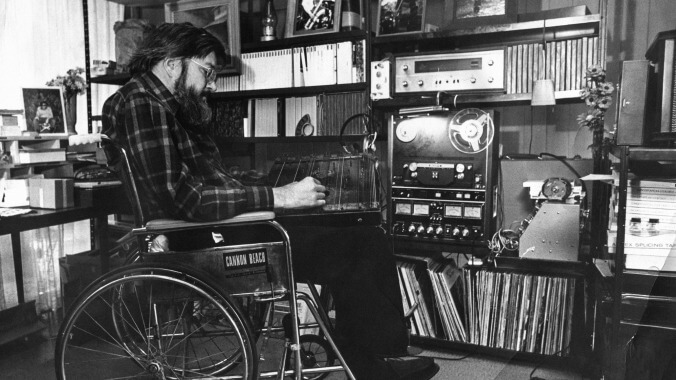Before Brian Eno made Music For Airports, Ernest Hood made music for Neighborhoods

In 1975, three years before Brian Eno introduced the word “ambient” to the world, Portland-based musician Ernest Hood quietly released his sole LP via private press. With its oatmeal-colored cover, delicately drawn lettering, and a subtitle declaring it to be “Memories of Times Past,” Neighborhoods was often slotted in the folk bin, when it was slotted anywhere at all.
But behind that sleeve dwelled a lovingly arranged set of songs comprising little more than rudimentary synthesizer, long strums of zither, and field recordings of children, cars, dogs, and chirping insects. Hood’s aim was to offer “joy in reminiscence” to his listeners by drawing them into a sepia-tinted portrait of American childhood situated in an aural landscape so gentle and non-threatening it seems like the Garden Of Eden replanted on the banks of the Columbia River.
Until recently, Neighborhoods only existed in Oregon thrift stores and on the fringe of ambient music’s recorded history. Though it shares a dedication to music as a quasi-physical space, it has little in common with the music that would follow; anyone looking for Satie gone American pastoral need look elsewhere. Hood favors an approach so homespun it may as well be macramé, and keeps his music as close to terra firma as possible. On “From The Bluff,” he lays the listener down onto the grass of a late-summer evening. Fireworks boom in the distance, while Hood idly accompanies on the zither and people chat nearby; you can practically smell the egg-salad sandwiches from a neighboring picnic basket.
This sense of immersion is partly owing to the quality of Hood’s field recordings. He had an incredible ear for the music of everyday life: clanging cash registers, the percussive growl of a car engine, the rich texture of a cricket in full drone. He came of age playing in jazz bands, where, somewhat incredibly, he was interpolating found sound as early as 1959. Those days served him well, teaching him how a well-deployed recording can blow some air into even the most crowded compositions. He places his sources carefully, setting crowd voices in the distance to suggest a sense of space, or sending an ice-cream truck past a gaggle of kids already enthralled by their popsicles. Dogs bark from four backyards over, the sound of an organ drifts in from next door.
It all serves to center Neighborhoods around the experience of life in a community. With his trills of synthesizer, Hood is one participant among many, his listeners joining him on the porch as he watches the day go by. Because his contributions are musical, and not vocal, he tends to flit around the edges of the scene she’s crafting, a friendly ghost who comments on what he sees without actually affecting it. His synths swirl through the trees. They flutter and flap and wave goodbye from the backseat of a departing car. He’s full of good humor—Laraaji with dirt under his fingernails.
When a young boy is teased for having “a sweetheart” in “After School,” Hood gamefully joins in the taunt, echoing their sing-song melody. He allows himself to be carried back to the giddy ecstasy of puppy love, and the schoolyard chant suddenly flushes and blooms and becomes dusted with the bittersweet melodies that swirl around it. It’s a generous reminder that childhood emotions aren’t childish in the moment they’re first felt, and a subtle suggestion that they live on well into our adulthood, even if they’ve become practically unrecognizable.
The net effect is strange—listening to kids talk about buying peanuts and 7Up shouldn’t be this interesting—and strangely sweet. There’s not even a hint of the darkness that lurks in most adult depictions of childhood, that sense of spoilage that seeps into any look back at better days: From this perspective, after all, we know that good times end. Instead, Hood seems to suggest that we can escape backwards to a childlike stability, even if only in our minds, even if we didn’t experience it ourselves. Such functional escapism, to use critic Grayson Haver Currin’s term, feels decadent in 2019, when the world demands so much engagement. But it also feels necessary. Call it sound healing for your inner child.